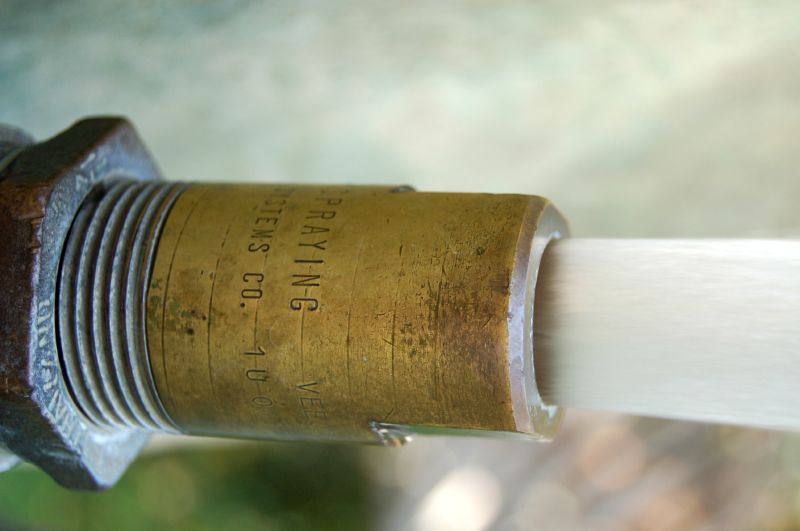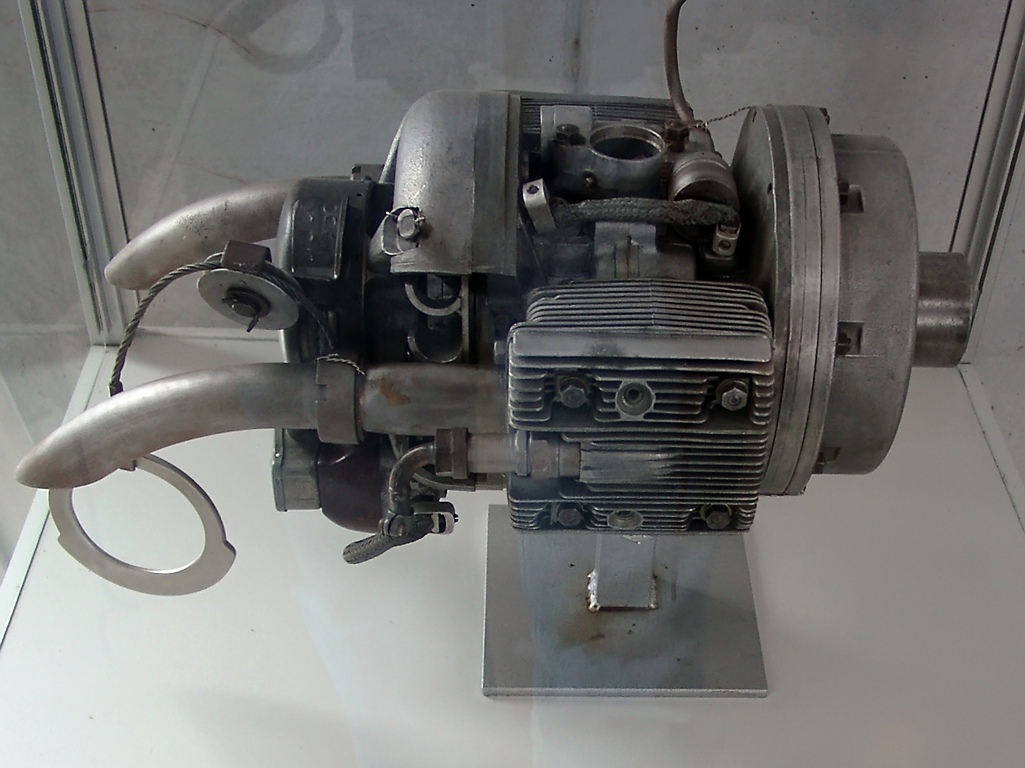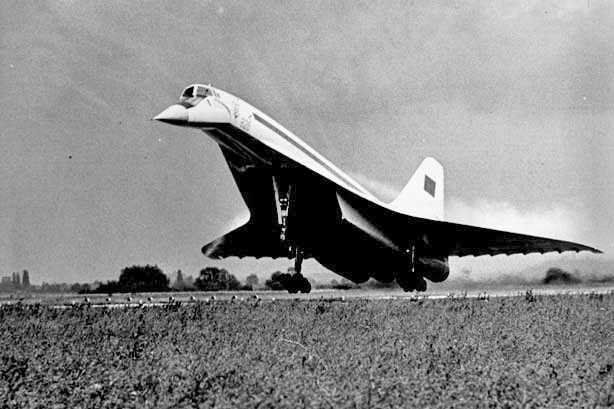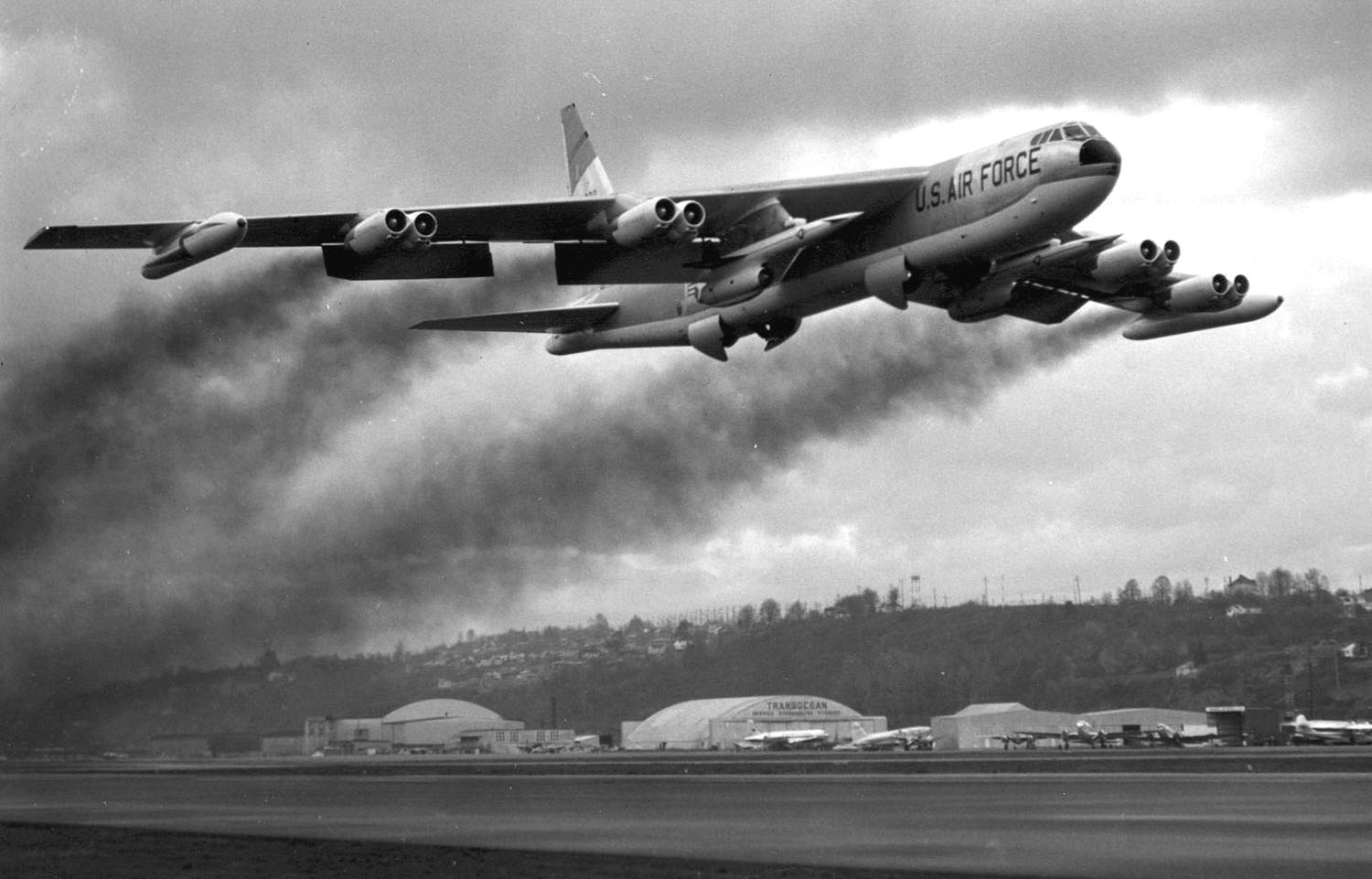|
Plug Nozzle
The plug nozzle is a type of nozzle which includes a centerbody or plug around which the working fluid flows. Plug nozzles have applications in aircraft, rockets, and numerous other fluid flow devices. Hoses Common garden hose trigger nozzles are a simple example of the plug nozzle and its method of operation. In this example the nozzle consists of a conical or bell shaped opening with a plug on a movable rod positioned in front of the nozzle. The plug looks similar to a poppet valve. The stem of the valve runs back through the body of the nozzle body to a "trigger", normally a long lever running down the back of the nozzle assembly. A spring keeps the valve pressed against the opening under normal use, thereby providing a failsafe cut-off that stops the flow of water when the nozzle is dropped. When water is supplied to the hose, it flows through the nozzle body to the opening, where it would normally flow straight forward in a stream. Just after leaving the opening it encoun ... [...More Info...] [...Related Items...] OR: [Wikipedia] [Google] [Baidu] |
Nozzle
A nozzle is a device designed to control the direction or characteristics of a fluid flow (specially to increase velocity) as it exits (or enters) an enclosed chamber or pipe (material), pipe. A nozzle is often a pipe or tube of varying cross sectional area, and it can be used to direct or modify the flow of a fluid (liquid or gas). Nozzles are frequently used to control the rate of flow, speed, direction, mass, shape, and/or the pressure of the stream that emerges from them. In a nozzle, the velocity of fluid increases at the expense of its pressure energy. Types Jet A gas jet, fluid jet, or hydro jet is a nozzle intended to eject gas or fluid in a coherent stream into a surrounding medium. Gas jets are commonly found in gas stoves, ovens, or barbecues. Gas jets were commonly used for Gas lighting, light before the development of electric light. Other types of fluid jets are found in carburetors, where smooth calibrated orifices are used to regulate the flow of gasoline, fuel ... [...More Info...] [...Related Items...] OR: [Wikipedia] [Google] [Baidu] |
Convergent-divergent Nozzle
A de Laval nozzle (or convergent-divergent nozzle, CD nozzle or con-di nozzle) is a tube which is pinched in the middle, with a rapid convergence and gradual divergence. It is used to accelerate a compressible fluid to supersonic speeds in the axial (thrust) direction, by converting the thermal energy of the flow into kinetic energy. De Laval nozzles are widely used in some types of steam turbines and rocket engine nozzles. It also sees use in supersonic jet engines. Similar flow properties have been applied to jet streams within astrophysics. History Giovanni Battista Venturi designed converging-diverging tubes known as Venturi tubes for experiments on fluid pressure reduction effects when fluid flows through chokes (Venturi effect). German engineer and inventor Ernst Körting supposedly switched to a converging-diverging nozzle in his steam jet pumps by 1878 after using convergent nozzles but these nozzles remained a company secret. Later, Swedish engineer Gustaf de Laval ... [...More Info...] [...Related Items...] OR: [Wikipedia] [Google] [Baidu] |
Expanding Nozzle
The expanding nozzle is a type of rocket nozzle that, unlike traditional designs, maintains its efficiency at a wide range of altitudes. It is a member of the class of altitude compensating nozzles, a class that also includes the plug nozzle and aerospike engine, aerospike. While the expanding nozzle is the least technically advanced and simplest to understand from a modeling point of view, it also appears to be the most difficult design to build. In the traditional bell nozzle the engine skirt is shaped to gradually flare out from the small-diameter exit from the combustion chamber, growing larger further from the chamber. The basic idea is to lower the pressure of the exhaust by expanding it in the nozzle, until it reaches ambient air pressure at the exit. For operations at sea level the skirt is generally short and highly angled, at least in comparison to a skirt designed for operations in space, which are longer and more gradually shaped. This means that a rocket engine that sp ... [...More Info...] [...Related Items...] OR: [Wikipedia] [Google] [Baidu] |
Bell Nozzle
The bell-shaped or contour nozzle is probably the most commonly used shaped rocket engine nozzle. It has a high angle expansion section (20 to 50 degrees) right behind the nozzle throat; this is followed by a gradual reversal of nozzle contour slope so that at the nozzle exit the divergence angle is small, usually less than a 10 degree half angle. An ideal nozzle would direct all of the gases generated in the combustion chamber straight out the nozzle. That would mean the momentum of the gases would be axial, imparting the maximum thrust to the rocket. In fact, there are some non-axial components to the momentum. In terms of a momentum vector, there is an angle between the axis of the rocket engine and the gas flow. As a result, the thrust is lowered by varying amounts. The bell or contour shape is designed to impart a large angle expansion for the gases right after the throat. The nozzle is then curved back in to give a nearly straight flow of gas out the nozzle opening. The co ... [...More Info...] [...Related Items...] OR: [Wikipedia] [Google] [Baidu] |
BMW 003
The BMW 003 (full RLM designation 109-003) is an early axial turbojet engine produced by BMW AG in Germany during World War II. The 003 and the Junkers Jumo 004 were the only German turbojet engines to reach production during World War II. Work had begun on the design of the BMW 003 before its contemporary, the Jumo 004, but prolonged developmental problems meant that the BMW 003 entered production much later, and the aircraft projects that had been designed with it in mind were re-engined with the Jumo powerplant instead. The most famous case of this was the Messerschmitt Me 262, which used the 003 in two of the V-series prototypes and in the two experimental A-1b aircraft. The only production aircraft to use the BMW 003 were the Heinkel He 162 and the later C-series, four-engined versions of the Arado Ar 234. About 3,500 BMW 003 engines were built in Germany, but very few were ever installed in aircraft. The engine also formed the basis for turbojet development in Japan ... [...More Info...] [...Related Items...] OR: [Wikipedia] [Google] [Baidu] |
Jumo 004
The Junkers Jumo 004 was the world's first production turbojet engine in operational use, and the first successful axial compressor turbojet engine. Some 8,000 units were manufactured by Junkers in Germany late in World War II, powering the Messerschmitt Me 262 fighter and the Arado Ar 234 reconnaissance/bomber, along with prototypes, including the Horten Ho 229. Variants and copies of the engine were produced in Eastern Europe and the USSR for several years following the end of WWII. Design and development The feasibility of jet propulsion had been demonstrated in Germany in early 1937 by Hans von Ohain working with the Heinkel company. Most of the Reich Air Ministry ( RLM) remained uninterested, but Helmut Schelp and Hans Mauch saw the potential of the concept and encouraged Germany's aero engine manufacturers to begin their own programmes of jet engine development. The companies remained skeptical and little new development was carried out. In 1939 Schelp and Mauch visited ... [...More Info...] [...Related Items...] OR: [Wikipedia] [Google] [Baidu] |
NASA
The National Aeronautics and Space Administration (NASA ) is an independent agencies of the United States government, independent agency of the federal government of the United States, US federal government responsible for the United States's civil list of government space agencies, space program, aeronautics research and outer space, space research. National Aeronautics and Space Act, Established in 1958, it succeeded the National Advisory Committee for Aeronautics (NACA) to give the American space development effort a distinct civilian orientation, emphasizing peaceful applications in space science. It has since led most of America's space exploration programs, including Project Mercury, Project Gemini, the 1968–1972 Apollo program missions, the Skylab space station, and the Space Shuttle. Currently, NASA supports the International Space Station (ISS) along with the Commercial Crew Program and oversees the development of the Orion (spacecraft), Orion spacecraft and the Sp ... [...More Info...] [...Related Items...] OR: [Wikipedia] [Google] [Baidu] |
Tupolev Tu-144
The Tupolev Tu-144 (; NATO reporting name: Charger) is a Soviet supersonic airliner, supersonic passenger airliner designed by Tupolev in operation from 1968 to 1999. The Tu-144 was the world's first commercial supersonic transport aircraft with its prototype's maiden flight from Zhukovsky International Airport, Zhukovsky Airport on 31 December 1968, two months before the British-French Concorde. The Tu-144 was a product of the Tupolev Design Bureau, an OKB headed by aeronautics pioneer Aleksey Tupolev, and 16 aircraft were manufactured by the Voronezh Aircraft Production Association in Voronezh. The Tu-144 conducted 102 commercial flights, of which only 55 carried passengers, at an average service altitude of and cruised at a speed of around (Mach number, Mach 2). The Tu-144 first went supersonic on 5 June 1969, four months before Concorde, and on 26 May 1970 became the world's first commercial transport to exceed Mach 2. Reliability and developmental issues restricted the vi ... [...More Info...] [...Related Items...] OR: [Wikipedia] [Google] [Baidu] |
Kolesov RD-36-51
The Kolesov RD-36 was a supersonic turbojet engine used on various Soviet aircraft projects. Design and development Developed at OKB-36 (P. A. Kolesov) and produced at the Rybinsk Motor-Building Plant, the RD-36-51A engine was developed for the Tu-144D supersonic passenger aircraft. A simplified version with a fixed nozzle for the high-altitude Myasishchev M-17 was designated RD-36-51B. The engine developed a thrust of . The RD36-51A engine passed all state bench and flight tests in 1973–75 (with flight testing on the Tu-144D). The engine's specifications were: * Maximum thrust at take-off = * Maximum thrust during supersonic cruise = altitude = , speed = * Maximum thrust during subsonic cruise= altitude = , speed = * Temperature = * Diameter = * Length = * Weight = For the high-altitude M-17 "Stratosphera" aircraft (NATO reporting name Mystic-A) a single-shaft TRD RD36-51B was created. This was a modified version of the RD36-51A engine with an unregulated ... [...More Info...] [...Related Items...] OR: [Wikipedia] [Google] [Baidu] |
Pratt & Whitney J52
The Pratt & Whitney J52 (company designation JT8A) is an axial-flow dual-spool turbojet engine originally designed for the United States Navy, in the 40 kN (9,000 lbf) class. It powered the A-6 Intruder and the AGM-28 Hound Dog cruise missile. the engine was still in use in models of the A-4 Skyhawk. The engine is the basis for the Pratt & Whitney JT8D, a popular civilian low-bypass turbofan engine. Design and development The J52 was developed in the mid-1950s for the US Navy as a scaled-down derivative of the J57/JT3A. It was initially intended to power the A4D-3 Skyhawk, an advanced avionics model that was canceled in 1957. After being canceled, the U.S. Air Force selected the J52 to power the AGM-28 Hound Dog cruise missile. The engine was designed with several unique features for this application, including a "conical centerbody mounted in the intake" and a "variable central plug ... in the nozzle". Then, in 1958, the US Navy selected the engine to power what be ... [...More Info...] [...Related Items...] OR: [Wikipedia] [Google] [Baidu] |
AGM-28 Hound Dog
The North American Aviation AGM-28 Hound Dog was a supersonic, turbojet, turbojet-propelled, Thermonuclear weapon, nuclear armed, air-launched cruise missile developed in 1959 for the United States Air Force. It was primarily designed to be capable of attacking Soviet Air Defence Forces#Cold War, Soviet ground-based air defense sites prior to a potential air attack by Boeing B-52 Stratofortress, B-52 Stratofortress long range bombers during the Cold War (1953-1962)#US Strategy – "Massive retaliation" and "brinksmanship", Cold War. The Hound Dog was first given the designation B-77, then redesignated GAM-77, and finally AGM-28. It was conceived as a temporary standoff missile for the B-52, to be used until the GAM-87 Skybolt air-launched ballistic missile was available. Instead, the Skybolt was cancelled within a few years and the Hound Dog continued to be deployed for a total of 15 years until its replacement by newer missiles, including the AGM-69 SRAM and then the AGM-86 ALCM. ... [...More Info...] [...Related Items...] OR: [Wikipedia] [Google] [Baidu] |
Plug Nozzle Garden Sprayer
Plug, PLUG, plugs, or plugged may refer to: * Plug, an insertive closure or stopper (plug) ** Core plug, used to fill the casting holes on engines ** Butt plug, a sex toy that is inserted into the rectum ** Earplug for ear protection ** Plug (sanitation), a stopper for a drainage outlet * Plug (accounting), an unsupported adjustment to an accounting record * Plug (fishing), a family of fishing lures * Plug (horticulture), a planting technique * Plug (jewellery), a type of jewellery worn in stretched piercings * Fusible plug, a safety device in steam boilers * Hair plug, hair that has undergone hair transplantation * Mating plug, secretion used in the mating of some animal species * Plug, a step in the manufacturing process for parts made of carbon-fiber-reinforced polymer * Plug, a type of chewing tobacco made by pressing tobacco with syrup * Plug, the central element of a Plug and feathers, a tool for splitting stone * Plug computer, a type of small-form-factor computer * Port ... [...More Info...] [...Related Items...] OR: [Wikipedia] [Google] [Baidu] |







